Research on Temperature Distribution of Large Permanent Magnet Synchronous Direct Drive Wind Turbine
Abstract
:1. Introduction
2. Permanent Magnet Synchronous Direct Drive Wind Turbine Magnetic Field Analysis and Loss Calculation
2.1. Principles of Electromagnetic Analysis
2.2. Maxwell 2D Modeling Analysis
2.3. Analysis of Electromagnetic Field Post-Treatment of Generator-Rated Load Conditions
2.4. Electromagnetic Field Post-Processing of Generator Three-Phase Short-Circuit Working Conditions
3. Analysis of Cooling and Heat Transfer Principle of Permanent Magnet Synchronous Direct Drive Wind Turbine
3.1. Select the Cooling Method of Permanent Magnet Synchronous Direct Drive Wind Turbine
- (1)
- The natural air-cooling effect is not good, but the cooling is easy to achieve, the cost is low, the reliability is high, and the maintenance cost is also low. Wind turbines using natural air cooling are generally micro and small with slightly higher speeds, few poles, and a single capacity of less than 1 MW;
- (2)
- The forced air-cooled cooling effect is much better than the natural air-cooling effect, but an independent cooling fan is required, the cost is increased, the structural complexity is increased, the reliability is reduced, and the maintenance cost is relatively increased. Forced air-cooled wind turbines are generally medium and large with high speeds, many poles, and a single capacity between 1 MW and 5 MW;
- (3)
- Water cooling is to design a cooling water jacket on the outer surface of the generator, and use an independent water pump to drive the cooling water to flow continuously in the cooling water jacket; the cooling water needs to be treated by the water treatment system. The cooling effect is much better than the free and forced air cooling effects. However, the cooling water jacket and cold-water treatment system need to consider the turbidity of water, water blockage and leakage, and water is easy to freeze in winter. In addition, the structure is more complex, the reliability is low, and the manufacturing cost, installation cost, and maintenance costs are greatly increased. Water-cooled wind turbines are generally large wind turbines with high speed, many poles, and a single capacity between 5 MW and 10 MW;
- (4)
- Other cooling methods mainly include hydrogen and double water internal cooling, which are rarely used. Mainly used in extra-large wind turbines, such as excitation generators, the capacity has reached 1300 MW, and the permanent magnet generator currently reaches 12 MW. However, the cost is extremely high, the structure is complex, and it is generally not considered.
3.2. Analysis of Heat Transfer Principle Permanent Magnet Synchronous Direct Drive Wind Turbine
- (1)
- Heat conduction. The essence of heat conduction’s heat transfer principle is that different objects at different temperatures contact each other or parts of the same object at different temperatures, and the party with the higher temperature transfers kinetic energy to molecules and electrons with low kinetic energy in the lower temperature via molecules and electrons with high internal kinetic energy. In the actual heat transfer, the heat field is transferred in three-dimensional space, and according to the relationship between the temperature field and the heat source established by Myerty, the heat conservation formula is:
- (2)
- Thermal radiation. Thermal radiation’s heat transfer principle is essentially the rated process of heat dissipation from the heating object to the surroundings. The ability to radiate heat is proportional to the object’s own temperature. Radiant heat dissipation does not require any medium, but is affected by the material of the object, the contact area of the object, the temperature of the object itself, and the roughness of the surface of the object. According to Stephen–Boltzmann’s law, the amount of heat radiated and dissipated by a heat-generating object per unit of time is
- (3)
- Thermal convection. The principle of heat transfer of heat convection means that heat transfer is achieved through the movement of the fluid. Of course, thermal convection is also a necessary condition for heat dissipation based on the temperature difference between the fluid and the heating element. In the process of heat convection, when the fluid flows through the surface of the heating element, the heating element with high heat transfers the heat to the fluid with low heat and radiates the heat to the fluid through heat exchange, and finally the heat is taken away by the fluid. The heat emitted by generators, permanent magnets, stator windings, motor shafts and bearings, and other heating parts are taken away to achieve the purpose of cooling the generator when natural air cooling and forced air cooling permanent magnet wind turbine cooling methods are used. According to Newton’s cooling formula, the calculation of heat convection can be expressed as:
4. Research on Temperature Distribution of Permanent Magnet Synchronous Direct Drive Wind Turbine
4.1. Build a Model
- (1)
- The stator groove of the wind turbine is evenly filled by flat copper winding, air, winding paint film, insulation and dip paint, and the thermal conductivity of the same material is the same. Then, the winding paint film, insulation, and dip paint are equivalent to a heat conductor, and the axial thermal conductivity and radial thermal conductivity of the solid structure after the equivalent are exactly the same. The equivalent model is shown in Figure 6;
- (2)
- Because the Maxwell model does not calculate the end winding loss, the temperature rise of the end winding is not considered; the winding is straight, the section is rectangular, and there is no bending part. The two layers of windings are equivalent to a whole, and the insulation material evenly wraps the windings;
- (3)
- The heat dissipation coefficient of the outer surface of the stator of the wind turbine, the end faces on both sides, the end faces on both sides of the rotor, and the end faces on both sides of the permanent magnet are the same, ignoring the changes caused by uneven temperature distribution;
- (4)
- The thermal conductivity of wind turbine stator, rotor, insulation, winding, and permanent magnet materials does not change with temperature;
- (5)
- The friction loss of the shaft is far less than the loss of the rain winding, so it is ignored.
4.2. Model Pre-Processing
- (1)
- Add materials, and calculate thermal conductivity and heat dissipation coefficient. Individual component materials are added to the fluent to ensure correct heat transfer and conductivity. Based on the experience of previous researchers and references [2,4,7]. Add the installation Table 2, Table 3 and Table 4 to set the setting;
- (2)
- Import the heat source and set the fluid. For the solid windings, stators, rotors, and permanent magnets that generate heat sources, it is also necessary to check the Source Terms, calculate the Maxwell electromagnetic field to the rated working condition heat source of the wind turbine, and import the corresponding heat source solids, respectively. Set the initial forced wind speed of the inlet to 20 m/s and the initial ambient temperature is 25 °C. The fluid outlet is set to natural convection, and nothing else is set. On the end face of the stator and rotor, the permanent magnet and the outer surface of the stator set the corresponding heat dissipation coefficient and heat flow coefficient according to Table 3 and Table 4.
4.3. Generator-Rated Load Condition Post-Processing Model
4.4. Post-Processing Model of Generator Three-Phase Short-Circuit Condition
4.5. Research on Generator Temperature Rise Distribution
5. Experimental Verification
6. Conclusions
- (1)
- Through finite element analysis, calculation, and comparison with the experiment, the difference between the measured values in the experiment is relatively small. The measured values in the experiment are partially greater than the simulated temperature values, while some are less than the temperature values. The minimum error under rated load condition is 1.05%, the maximum error is 3.3%, and the average error is 2.30%. The minimum error under the three-phase short-circuit condition is 1.5%, the maximum error is 3.62%, and the average error is 2.26%. The small difference with the engineering error range requirements further confirms the reliability of the analysis and the feasibility of the magnetic thermal flow field coupling analysis method for direct drive wind turbines;
- (2)
- The wind and stator are the main heat sources, with higher temperatures. The axial temperature increases with the increase of axial distance, and both show a linear distribution. The temperature of the components near the stator core and winding is relatively high, reaching a maximum value of about 180 mm near the fluid outlet side. However, the maximum value for three-phase short circuit conditions is slightly earlier, and the overall temperature is much higher than the rated load condition. The maximum temperature difference for the same axial length is about 120 °C. The temperature of the upper winding under both operating conditions is higher than that of the lower winding, and the temperature difference under three-phase short circuit conditions is relatively large.
- (3)
- The flow velocity at the inlet of the fluid is relatively high, while the flow velocity at the outlet is relatively low. As a result, the temperature at the inlet of the fluid is relatively low, while the temperature at the outlet is relatively high.
Author Contributions
Funding
Data Availability Statement
Conflicts of Interest
References
- Shan, L. Wind Turbine Design and Simulation Example; Science Press: Beijing, China, 2017. [Google Scholar]
- Ding, S.; Wu, C. Internal flow heat characteristics of 5 MW doubly-fed wind turbine with radial ventilation structure. Electr. Mach. Control 2019, 23, 68–76. [Google Scholar] [CrossRef]
- Wu, S.; Li, W.; An, Z.; Yu, S. Thermal analysis of variable speed and constant pressure hybrid excitation wind turbine. Trans. China Electrotech. Soc. 2019, 34, 1857–1864. [Google Scholar] [CrossRef]
- Zhu, G.; Liu, X.; Li, L.; Gao, S.; Tong, W. Design and analysis of air-cooled structure of permanent magnet wind turbine. Trans. China Electrotech. Soc. 2019, 34, 946–953. [Google Scholar] [CrossRef]
- Wei, J.; Huang, Q.; Tan, Y.; Wu, H. Analysis and improvement of thermal performance of 2MW air-cooled wind turbine. J. Harbin Univ. Sci. Technol. 2016, 21, 79–83. [Google Scholar] [CrossRef]
- Wang, J.; Li, X.; Zhang, Y.; Wang, K. Temperature field analysis under different working conditions based on CFD water-cooled traction motor. Mach. Des. Manuf. 2022, 10, 196–200. [Google Scholar] [CrossRef]
- Lee, J.-S.; Ryu, J.H.; Lee, C.-M. Thermal Analysis of Interior Permanent Magnet Synchronous Motor for High-Speed Train Depending on Cooling Structure. J. Korean Soc. Railw. 2020, 23, 326–338. [Google Scholar] [CrossRef]
- Qi, J.; Hua, W.; Zhang, H. Investigators at Southeast University Report Findings in Magnetics (Thermal Analysis of Modular-spoke-type Permanent-magnet Machines Based On Thermal Network and Fea Method). J. Technol. Sci. 2019, 99, 1–5. [Google Scholar]
- Dong, B.; Wang, K.; Han, B.; Zheng, S. Thermal Analysis and Experimental Validation of a 30 kW 60000 r/min High-Speed Permanent Magnet Motor with Magnetic Bearings. IEEE Access 2019, 7, 92184–92192. [Google Scholar] [CrossRef]
- Yang, S.; Wang, T.; Dai, Y.; Wang, R. Thermal analysis and cooling structure design of high-speed asynchronous spindle motor. Mot. Control Appl. 2022, 49, 80–87. [Google Scholar]
- Wang, S.; Wu, B.; Wen, W.; He, J. Thermal analysis of new energy vehicle motor based on heat pipe-air cooling system. Mot. Control Appl. 2018, 45, 91–97, 109. [Google Scholar]

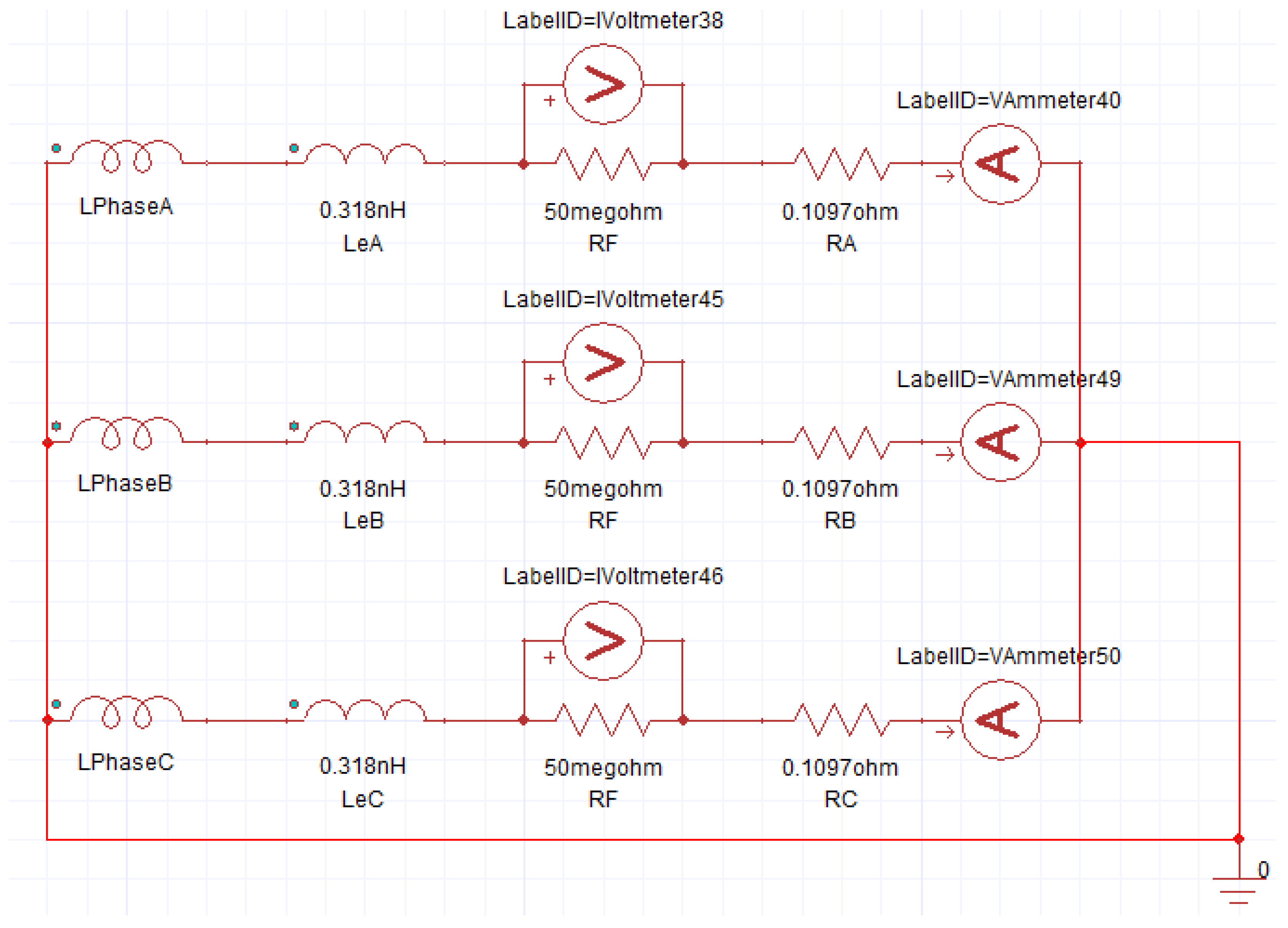
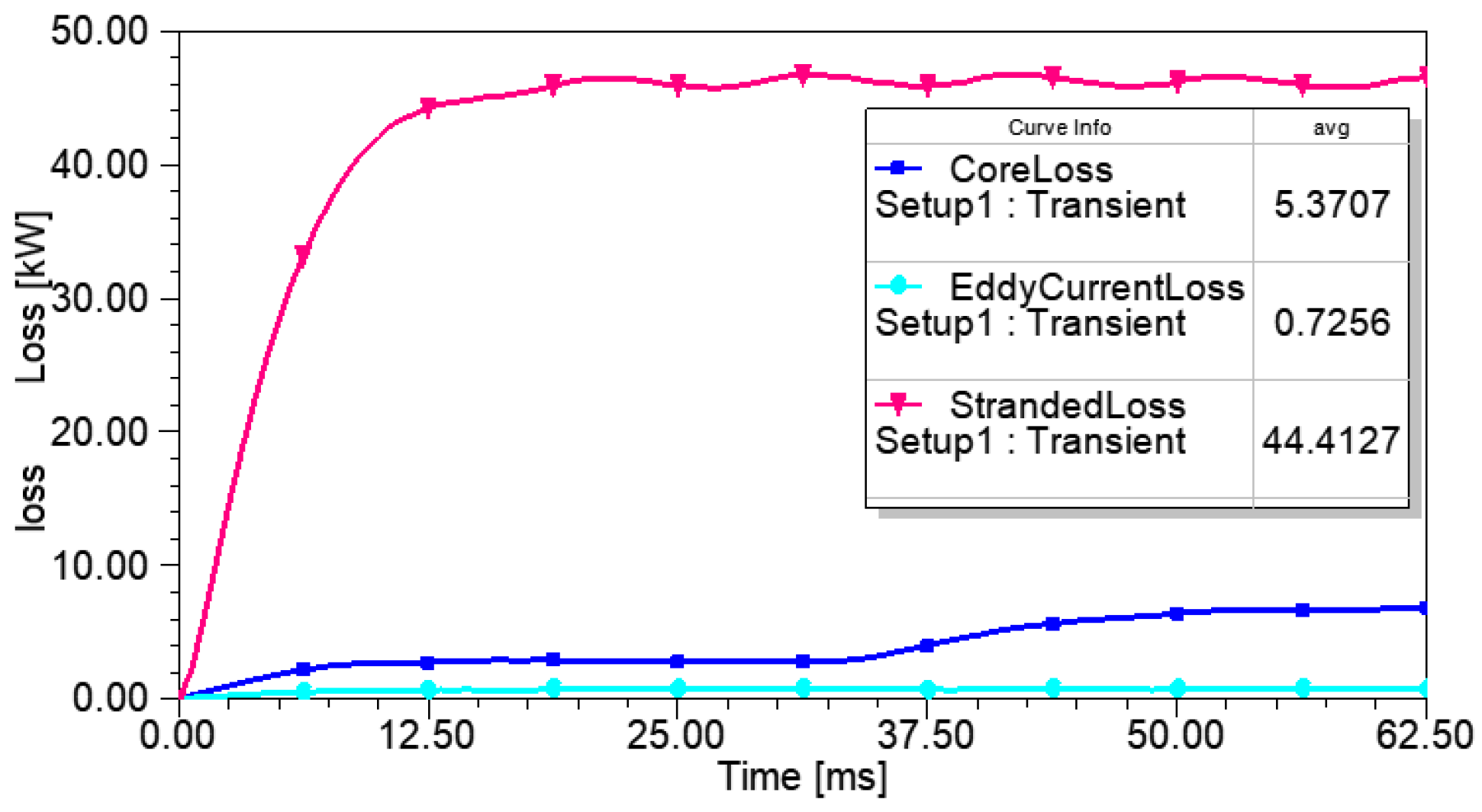
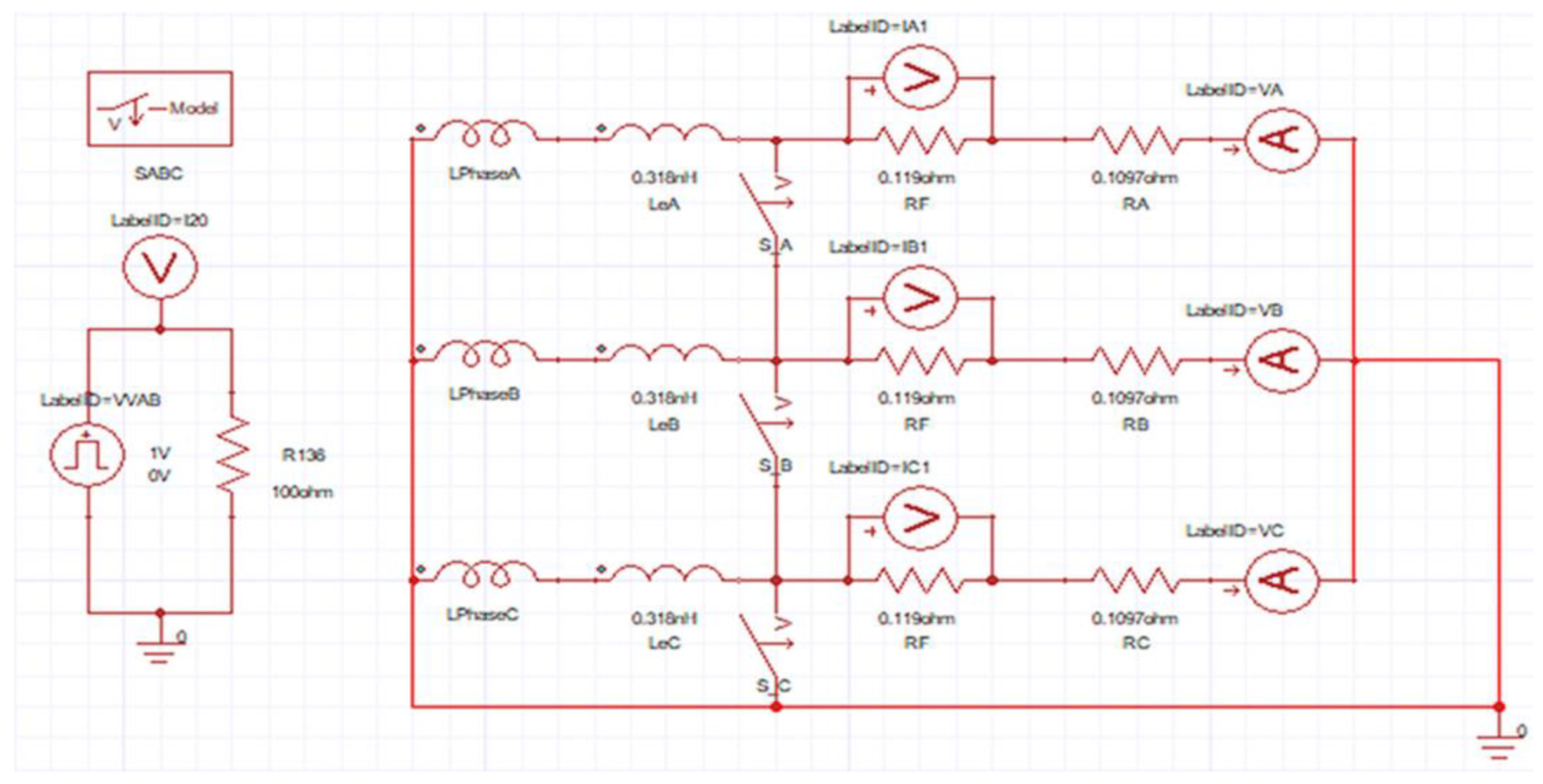
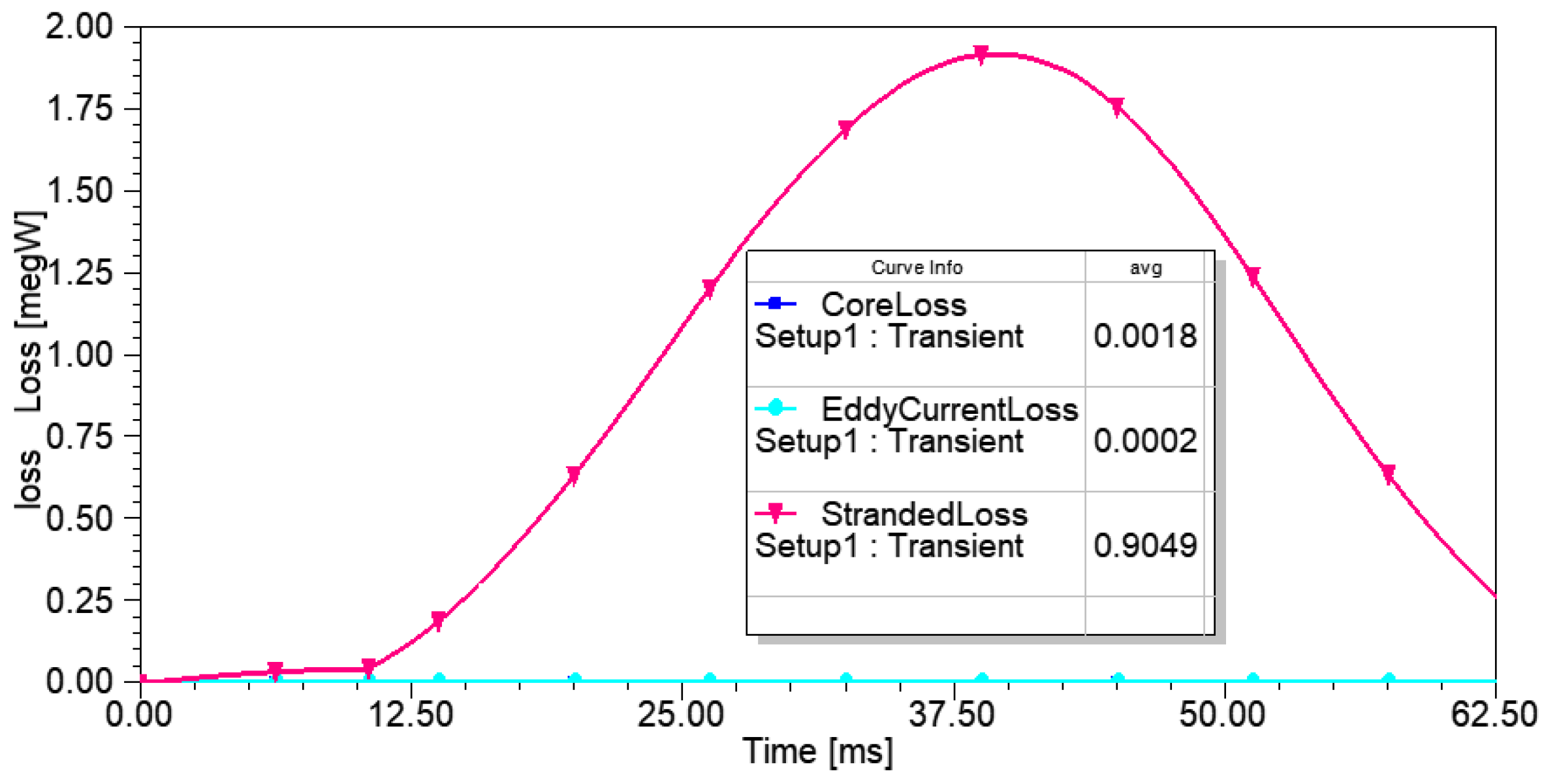
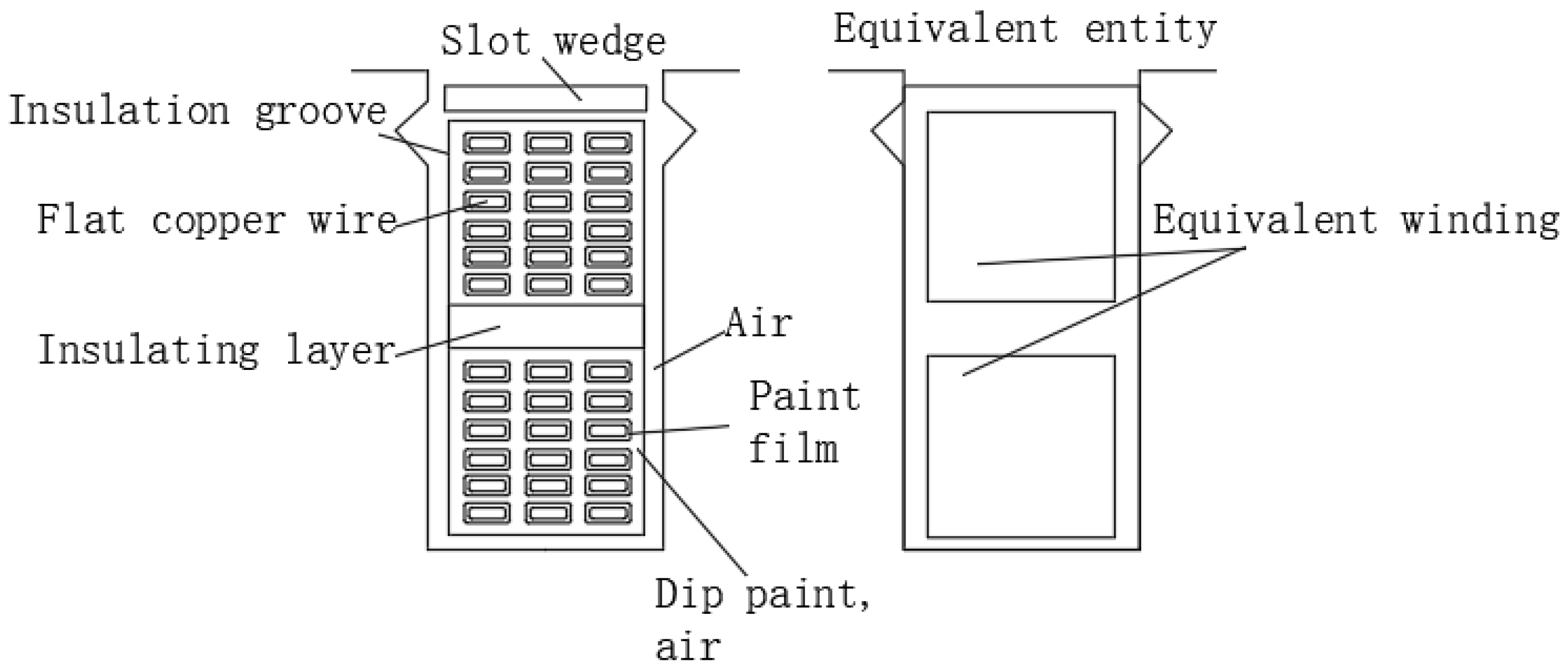

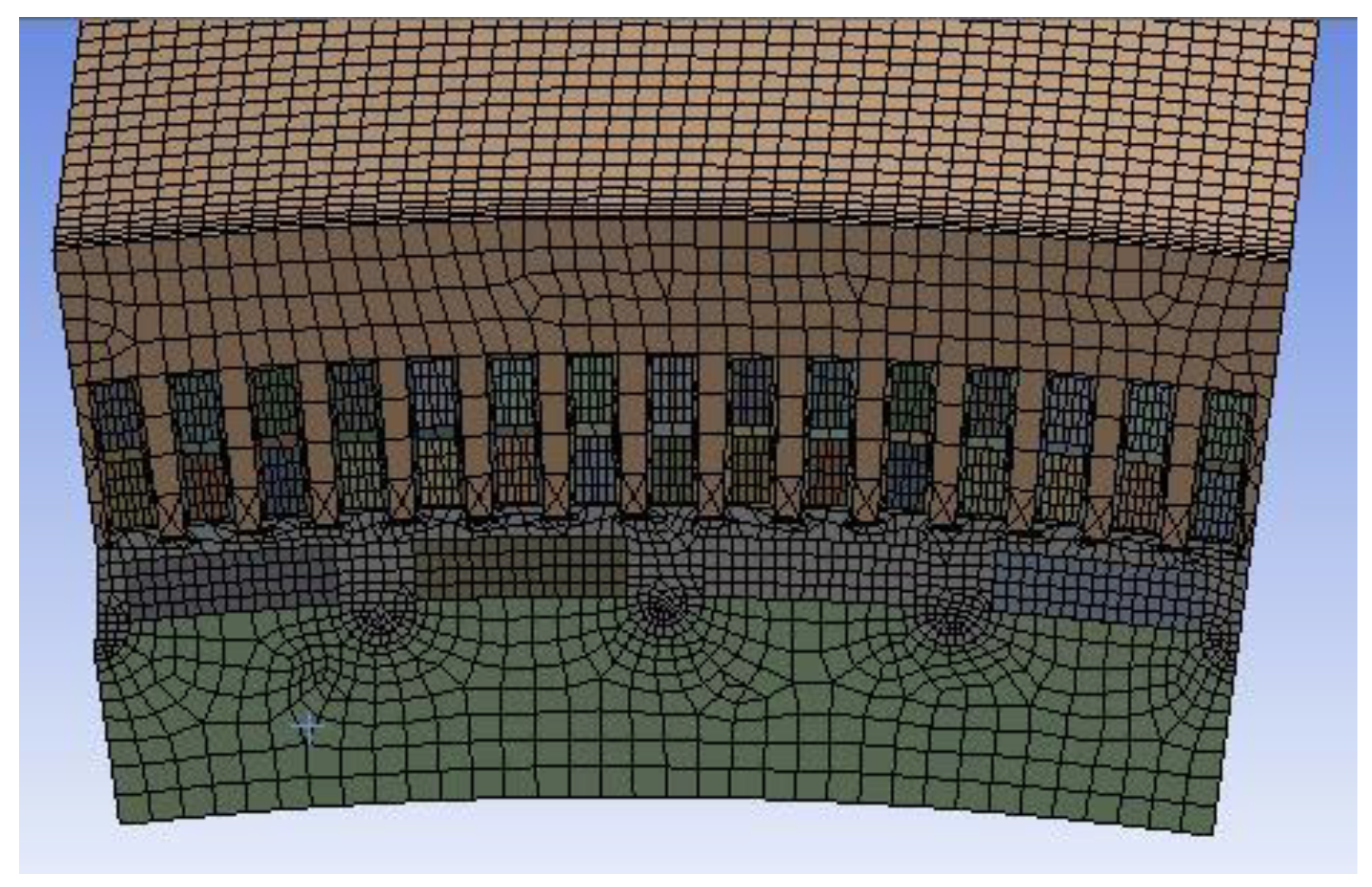
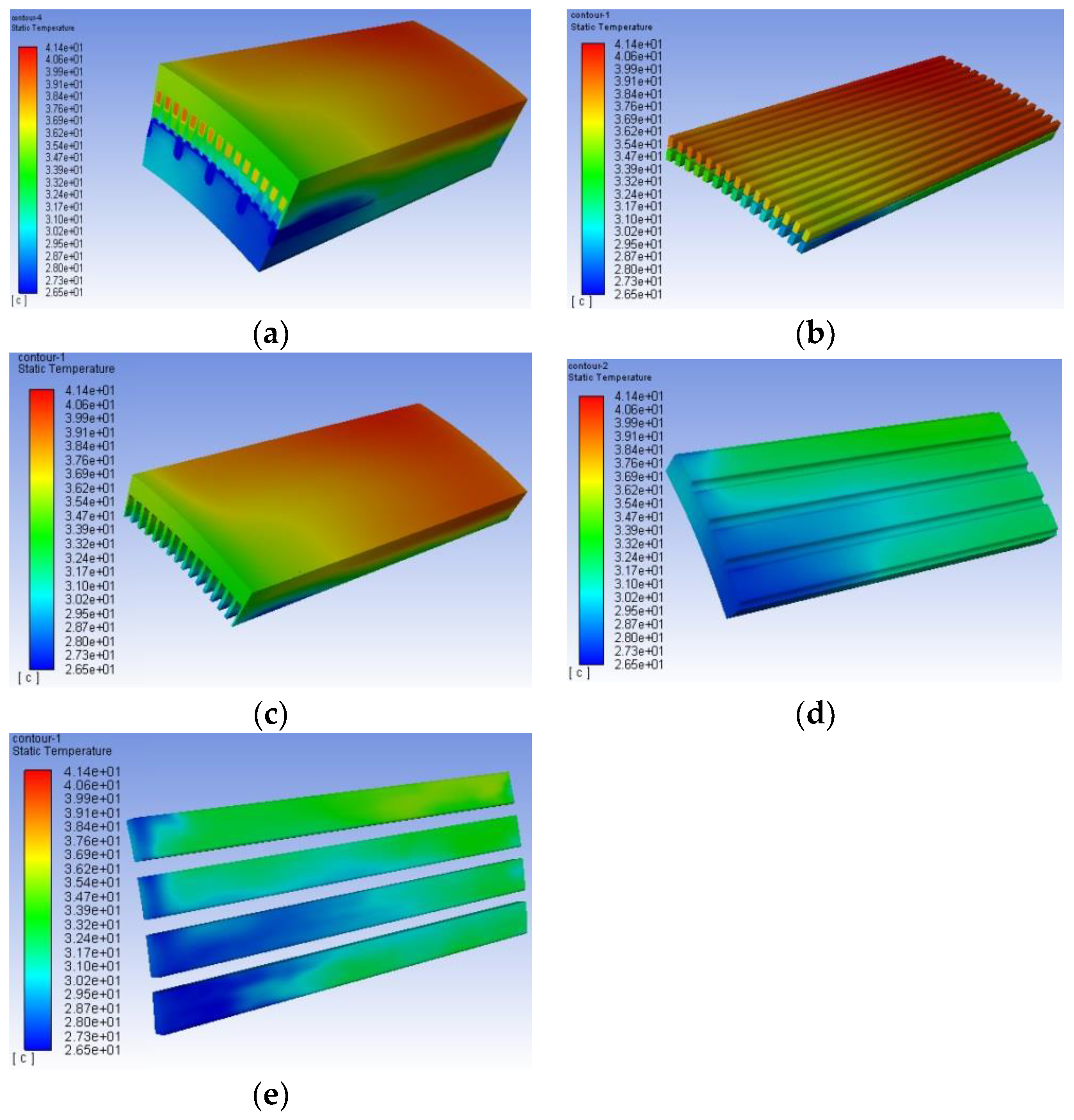
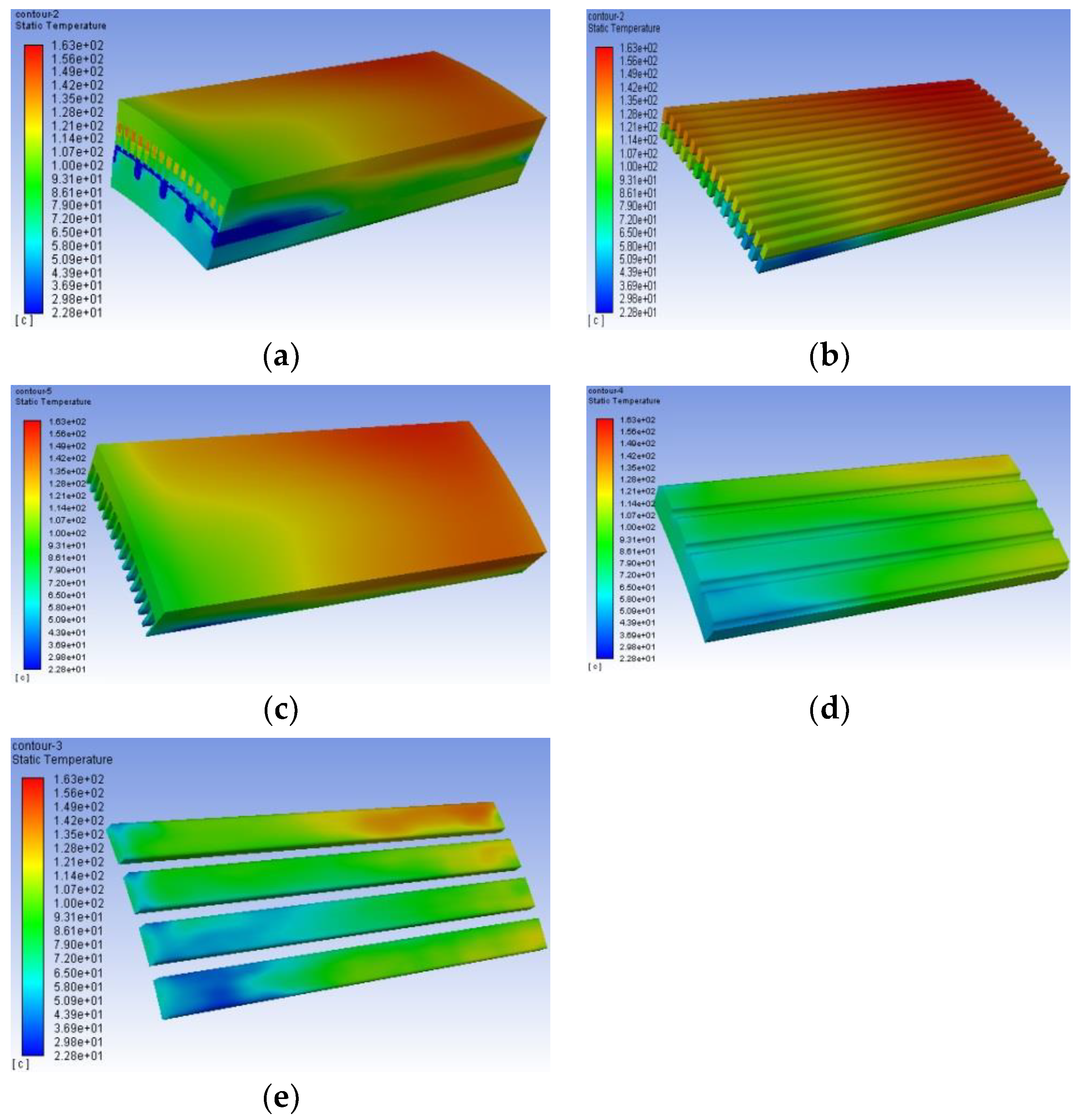



| Parameter Name | Parameter Value | Parameter Name | Parameter Value |
|---|---|---|---|
| Power | 4 MW | Stator inner diameter | 4125 mm |
| Number of phases | 3 phases | Stator outer diameter | 4425 mm |
| Number of poles | 96 | Rotor inner diameter | 3910 mm |
| Rotate speed | 20 rpm | Rotor outer diameter | 4110 mm |
| Frequency | 16 Hz | Core length | 1480 mm |
| Voltage | 690 V | Parallel branch roads | 8 |
| Number of slots | 360 | Per slot conductor | 10 |
| Parts | Material | Specific Heat Capacity/[J/(kg·°C) | Density/(kg/m3) | Thermal Conductivity/[W/(m·°C) |
|---|---|---|---|---|
| Stator | DW315-50 | 460 | 7800 | 42.5 |
| Rotor | DW315-50 | 460 | 7800 | 42.5 |
| Magnet | NdFe35 | 410 | 7400 | 8 |
| Rotating shaft | 42CrMoA | 461 | 7850 | 43.2 |
| Winding | Copper (equivalent) | 400 | 8954 | 400 |
| Air gap | air | 1006.43 | 1.225 | 0.0242 |
| Dipped paint | Dip paint | 1700 | 950 | 0.17 |
| IKnsulation | Slot insulation | 1000 | 1400 | 0.2 |
| Varnish film | Paint film | 1750 | 800 | 0.14 |
| Part One | Part Two | Thermal Resistance Category | Thickness/mm | Density/(kg/m3) | Specific Heat Capacity/[J/(kg·°C) | Thermal Conductivity/[W/(m·°C) |
|---|---|---|---|---|---|---|
| Stator | Winding | Slot insulation | 0.4 | 1400 | 1000 | 0.16 |
| Stator | Rotor | Air | 1.3 | 1.225 | 1005 | - |
| Rotor | Shaft of rotation | Air | 0.01 | 1.225 | 1005 | 0.025 |
| Rotor | Permanent magnet | Air | 0.01 | 1.225 | 1.005 | 0.025 |
| Various Parts of the Wind Turbine | Heat Dissipation Coefficient/[W/(K·m) |
|---|---|
| The outer surface of the stator | 15 |
| Stator ends | 60 |
| End windings | 68 |
| Rotor ends | 40 |
| Permanent magnet surface | 40 |
| Temperature Measuring Element | Simulation Value/°C | Experimental Value/°C | Error/% |
|---|---|---|---|
| Component 1 | 28.14 | 27.34 | −2.93 |
| Component 2 | 29.17 | 29.84 | 2.25 |
| Component 3 | 30.34 | 31.21 | 2.79 |
| Component 4 | 31.56 | 32.51 | 2.92 |
| Component 5 | 33.14 | 33.97 | 2.44 |
| Component 6 | 35.72 | 34.58 | −3.30 |
| Component 7 | 37.69 | 37.23 | −1.24 |
| Component 8 | 38.77 | 39.18 | 1.05 |
| Component 9 | 37.46 | 38.53 | 2.78 |
| Component 10 | 37.35 | 36.82 | −1.44 |
| Component 11 | 36.13 | 35.36 | −2.18 |
| Temperature Measuring Element | Simulation Value/°C | Experimental Value/°C | Error/% |
|---|---|---|---|
| Component 1 | 65.33 | 63.84 | −2.33 |
| Component 2 | 80.26 | 78.35 | −2.44 |
| Component 3 | 93.17 | 96.67 | 3.62 |
| Component 4 | 112.64 | 110.98 | −1.50 |
| Component 5 | 126.89 | 129.13 | 1.73 |
| Component 6 | 136.47 | 138.71 | 1.61 |
| Component 7 | 143.54 | 148.68 | 3.46 |
| Component 8 | 158.76 | 161.23 | 1.53 |
| Component 9 | 148.92 | 152.38 | 2.27 |
| Component 10 | 139.57 | 136.18 | −2.49 |
| Component 11 | 130.24 | 127.88 | −1.85 |
Disclaimer/Publisher’s Note: The statements, opinions and data contained in all publications are solely those of the individual author(s) and contributor(s) and not of MDPI and/or the editor(s). MDPI and/or the editor(s) disclaim responsibility for any injury to people or property resulting from any ideas, methods, instructions or products referred to in the content. |
© 2023 by the authors. Licensee MDPI, Basel, Switzerland. This article is an open access article distributed under the terms and conditions of the Creative Commons Attribution (CC BY) license (https://creativecommons.org/licenses/by/4.0/).
Share and Cite
Huang, Z.; Liu, Q.; Hao, Y. Research on Temperature Distribution of Large Permanent Magnet Synchronous Direct Drive Wind Turbine. Electronics 2023, 12, 2251. https://doi.org/10.3390/electronics12102251
Huang Z, Liu Q, Hao Y. Research on Temperature Distribution of Large Permanent Magnet Synchronous Direct Drive Wind Turbine. Electronics. 2023; 12(10):2251. https://doi.org/10.3390/electronics12102251
Chicago/Turabian StyleHuang, Zhengjun, Quan Liu, and Yuxin Hao. 2023. "Research on Temperature Distribution of Large Permanent Magnet Synchronous Direct Drive Wind Turbine" Electronics 12, no. 10: 2251. https://doi.org/10.3390/electronics12102251




